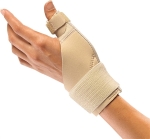Hand is a very important organ of the body. Disorders affecting the hand could lead to loss of hand function in various forms and degrees. Thumb itself accounts for over 40 percent function of the hand. It is imperative that the problems affecting the hand should be diagnosed and managed correctly. The following are the various disorders affecting the hand.
Hand problems include:
- Carpal tunnel syndrome - compression of a nerve as it goes through the wrist, often making your fingers feel numb
- Injuries that result in fractures (broken bones), ruptured ligaments and dislocations
- Osteoarthritis - wear-and-tear arthritis, which can also cause deformity
- Tendinitis - irritation of the tendons
- Disorders and injuries of your fingers and thumb
CONGENITAL ANOMALIES OF THE HAND:
Some of the important congenital anomalies of the hand are:
Polydactyly: It is a duplication of one or more digits and may require amputation for cosmetic purposes.
Syndactyly: This is fusion of digits and usually occurs between the middle and ring fingers and is 3 times more common in males.The fusion may be only in the skin or all the structures. In the latter case, surgery is done early at 18 months age and in the less severe former case, surgery is done after 5 years.
Macrodactyly: This is a rare congenital anomaly and is characterized by enlargement of all structures especially of the nerves of a single or more digits. It is often associated with neurofibromatosis, lymph-angioma, arteriovenous malformation, etc.
Congenital trigger digits: Thumb is more commonly involved. It is frequently bilateral and is due to flexion contracture of the distal joint of the thumb. More than 30 percent of these cases resolve after first year and the remaining may require surgical release after 2 years of age.
Streeter’s dysplasia: This is a syndrome of congenital constrictions, which may affect any part of the body. In the hand, it may range from simple constriction to congenital amputation. To prevent distal circulatory compromise, it frequently requires surgical release by Z-plasty.
Camptodactyly: This is a flexion contracture of the proximal interphalangeal joint especially of the little finger. It may rarely be seen in other fingers too. Severe deformity in older patients requires tendon lengthening procedures. Clinicodactyly is angulation of the finger in radioulnar direction. Mild clinicodactyly is seen in normal children, while the severe ones are associated with mental retardation.
Cleft hand (also called Lobster claw hand): This is frequently bilateral and is associated with cleft foot, cleft lip, cleft palate, etc. There are two varieties: in the first type, a deep palmar cleft separates the two central metacarpals; and in the second type, the central rays are absent .Both the varieties require surgical excision and Z- plasty.
Mirror Hand (reduplication of ulna): Here the ulna and carpus are reduplicated and there may be seven or eight fingers with no thumb. Pollicisation of a finger solves the problem of the absent thumb.
Congenital absence of radius or ulna: Congenital absence of radius is more common than that of ulna. The radius may be completely absent or in parts. The forearm is short, wrist is highly unstable and the hand is deviated radially. It requires complex and difficult surgical corrections. This deformity of radius absence is also called radial club hand and the absence of ulna is called the ulnar club hand.
Kirner’s deformity: This is a spontaneous injuring of the terminal phalanx of the fifth digit. It is a rare disorder and is more often seen in females.
Infections of the Hand
The effects of hand infection can be as devastating as major trauma. Trivial injuries like a scratch, a prick, small punctured wounds, etc. cause hand infections. Staphylococcus aureus (80%) ,Streptococcus pyogenes and gram-negative bacilli are the famous trio who inflict the infective unmitigated disaster in the hand. The sequelae of these infections are edema, abscess, necrosis, fibrosis and lastly contractions leading to a grotesque, debilitating hand. The presence of an abscess seems to send a message to the surgeons, “Drain me I’ll drain Myself! ” Hence, an abscess caused should be drained; the surgeon only has to decide the proper time and incisions. Early use of potent antibiotics has considerably downed the threat of serious hand infections.
As elsewhere before we delve into the discussions on individual hand infections, it helps considerably to know the principles of treatment:
- Hands should be kept elevated to facilitate gravity to drain and thereby prevent edema and swelling of the hand.
- Following the treatment, the hand needs to be placed in functional position for optimum results.
- Early and appropriate use of IV antibiotics prevents pus formation (within 24-48 hours).
- If pus is formed, let it out through proper incisions at the appropriate time.
- Local anesthetic may help the spread of infection and adds more fluid to the already existing swelling. Hence, general anesthesia or regional block is preferred.
- Tourniquet is indicated, but exsanguinations are not preferred as it helps spread the infection (alternatively, elevation of hand for three minutes is ideal).
- Do not forget the all important hand aftercare, which has a direct bearing on the outcome of the hand function.
With the principles of treatment as a backdrop, let us now consider the important hand infections in order of importance.




